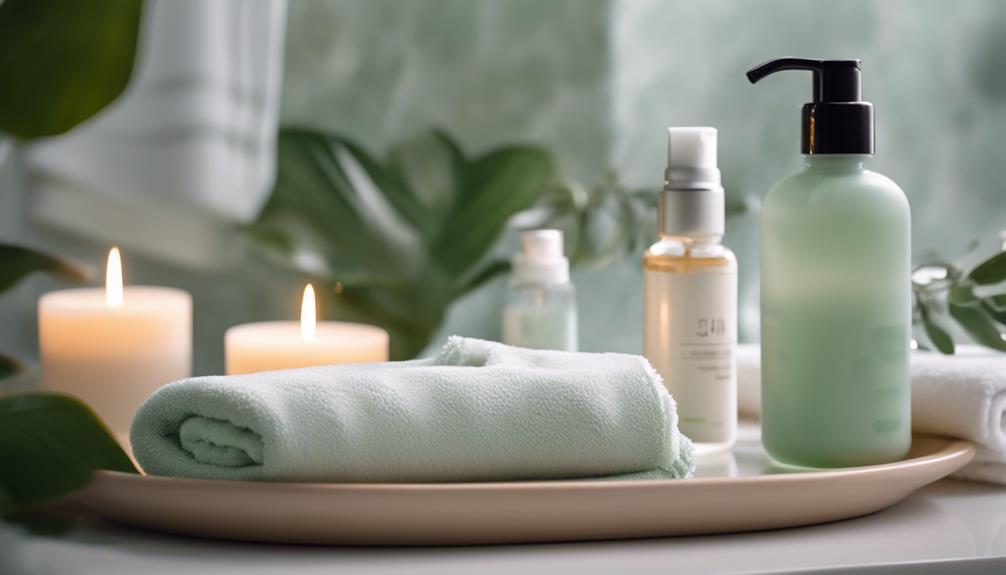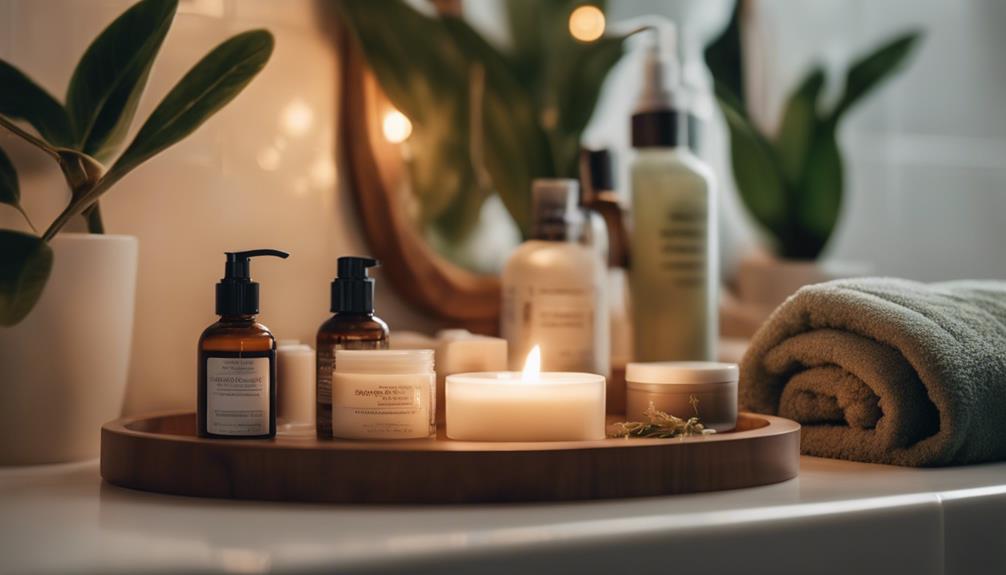To establish an efficient nighttime skincare routine, begin with double cleansing: use an oil-based cleanser first, followed by a water-based one to thoroughly remove impurities. Use a toner to restore your skin’s pH balance and prepare it for serums. Then, select a targeted treatment or serum tailored to your skin concerns, such as retinol or hyaluronic acid. Remember to apply an eye cream for the sensitive eye area, followed by a nourishing night cream. Finish by locking in moisture with a face oil. For more in-depth tips on each step, continue to explore the best practices for your nighttime skincare routine!
Key Takeaways
- Start with double cleansing: use an oil-based cleanser followed by a water-based cleanser to thoroughly remove makeup and impurities.
- Apply toner after cleansing to restore pH balance and enhance hydration, preparing the skin for better absorption of treatments.
- Use targeted treatments and serums to address specific skin concerns, applying them on dry skin post-toning for maximum effectiveness.
- Incorporate retinol gradually into your routine, applying it before moisturizers to improve texture and reduce signs of aging.
Importance of a Nightly Routine
A nightly skincare routine is essential for skin repair and regeneration, as your skin does most of its healing while you sleep. This time is critical for addressing various skin concerns, so you want to make the most of it. By incorporating targeted treatments like serums and retinols, you can directly tackle issues such as aging, acne, and discoloration.
Moreover, proper hydration during your nightly skincare is key. Using heavier moisturizers or night creams helps lock in moisture, allowing your skin to nourish itself overnight. This not only enhances your skin's barrier function but also promotes a plump, healthy appearance by morning.
Consistency is important; a dedicated nightly skincare routine leads to visible improvements in skin texture and tone over time. It's not just about looking good but also about maintaining your skin's health.
Skipping this routine, on the other hand, can lead to a buildup of dirt, makeup, and pollutants, causing clogged pores and breakouts. So, commit to your nightly skincare, and let your skin benefit from the restorative powers of a good night's sleep.
Step-by-Step Cleansing Process
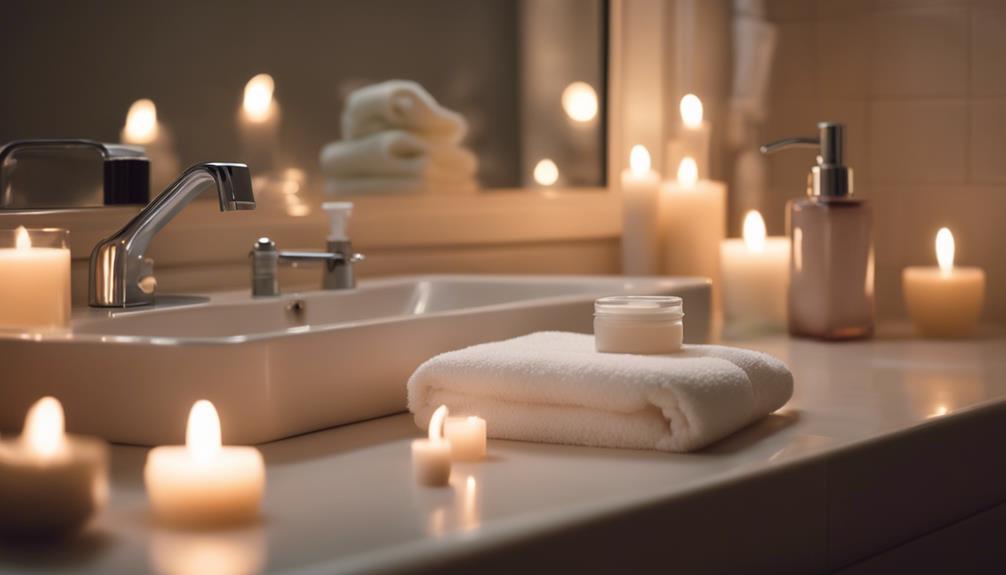
To kick off your cleansing process, you should consider the importance of double cleansing for thoroughly removing impurities.
Start with a makeup remover to tackle surface makeup, then follow up with a cleanser tailored to your skin type.
Choosing the right cleanser is essential for achieving a fresh and clean complexion at the end of the day.
Importance of Double Cleansing
Double cleansing is vital for achieving a truly clean complexion, as it effectively removes makeup, sunscreen, and impurities while preparing your skin for the next steps in your skincare routine. The process starts with an oil-based cleanser, which works to dissolve stubborn makeup and excess oils. This first step is essential because it allows you to cleanse without harsh scrubbing, minimizing irritation and keeping your skin happy.
After the oil cleanse, you'll follow up with a gentle water-based cleanser. This second cleanse removes any remaining debris, dirt, and sweat that may have accumulated throughout the day. By incorporating a double cleanse into your nightly routine, you greatly reduce the likelihood of clogged pores and breakouts.
Moreover, double cleansing enhances the overall effectiveness of your skincare routine. When your skin is thoroughly cleansed, active ingredients in serums and treatments can penetrate deeper, allowing them to work more effectively. Over time, this leads to clearer, healthier, and more radiant skin.
Choosing the Right Cleanser
Choosing the right cleanser is essential for setting the stage for effective skincare, guaranteeing your skin feels fresh and balanced before applying other products. Start with a makeup removal step using a cleansing oil or micellar water to eliminate makeup and surface impurities. This prepares your skin for a thorough cleanse.
For your second cleanse, choose a gentle cleanser that suits your skin type. A creamy formula works well for dry skin, while a gel cleanser is ideal for oily skin.
Here's a quick reference to help you decide:
| Skin Type | Recommended Cleanser |
|---|---|
| Dry | Creamy Cleanser |
| Oily | Gel Cleanser |
| Combination | Balancing Cleanser |
Use lukewarm water to open up your pores, enhancing the cleansing process. Gently massage the cleanser into your skin in circular motions for about 30 seconds. This guarantees a thorough cleansing without irritation. Finally, pat your face dry with a clean towel to maintain hydration and prepare your skin for the next steps in your nighttime routine.
Toning for Balanced Skin
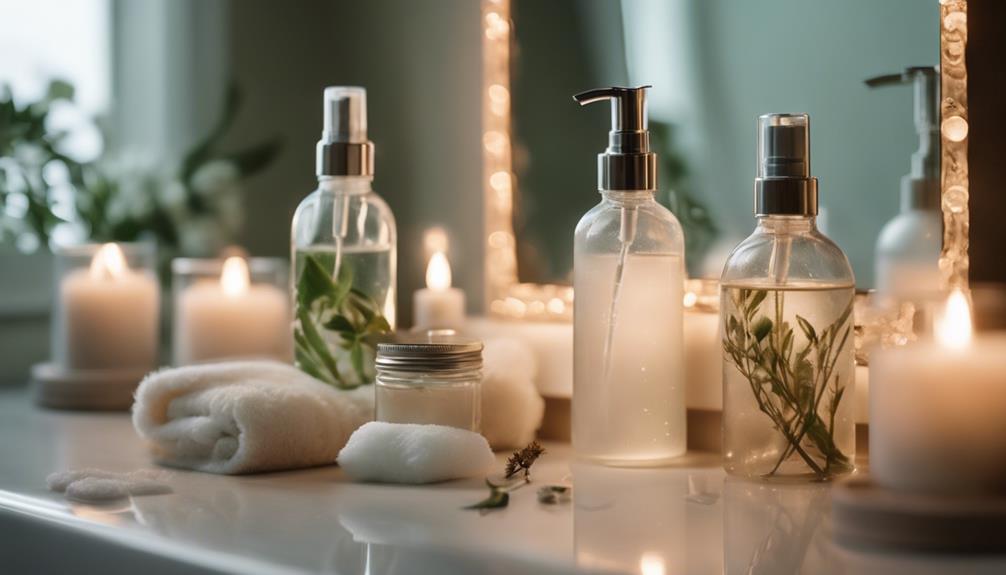
Toning plays an essential role in restoring your skin's pH balance after cleansing, guaranteeing it's primed for better absorption of the products that follow. Incorporating toning into your nightly routine can enhance your skin's overall health and appearance.
Here are three key benefits of using a toner:
- Restores pH Balance: After cleansing, your skin may become slightly alkaline. Toning helps bring it back to its ideal acidic state, which is vital for healthy skin function.
- Hydration Boost: Hydrating toners, often packed with ingredients like hyaluronic acid or rose water, provide an extra layer of moisture, making them a great choice for dry or sensitive skin types.
- Prepares for Next Steps: By applying toner, you enhance the absorption of your following skincare products, maximizing their effectiveness.
To apply toner effectively, soak a cotton pad or ball in the product and gently pat it onto your face. This method guarantees even distribution and allows your skin to soak up all the benefits.
Targeted Treatments and Serums
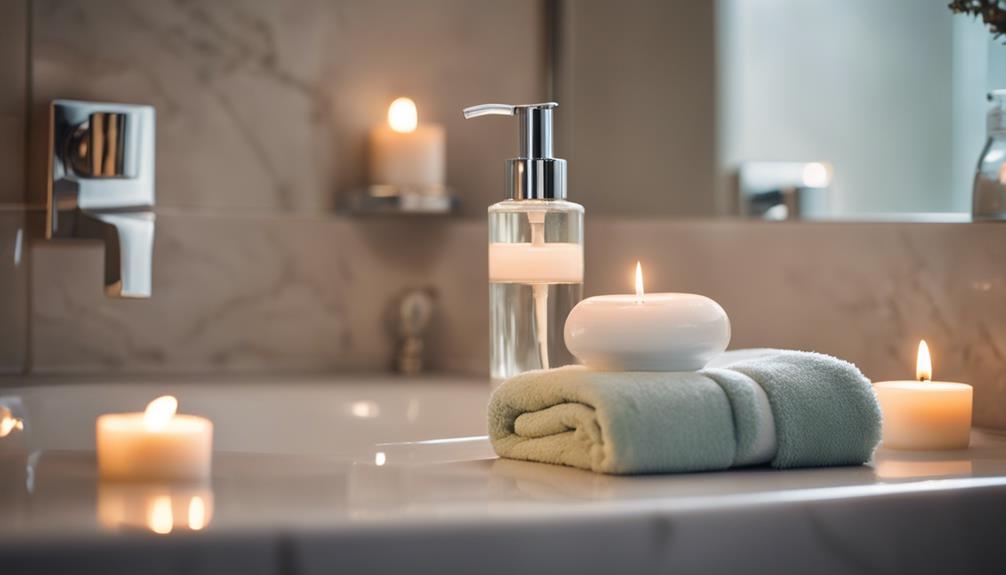
When it comes to your PM skincare routine, targeted treatments and serums play an essential role in addressing specific skin concerns.
You need to choose the right serum that aligns with your goals, whether it's brightening, anti-aging, or acne-fighting.
Applying these products in the correct order guarantees your skin gets the maximum benefits from each treatment.
Importance of Targeted Treatments
Targeted treatments are essential for effectively addressing specific skin concerns like acne, fine lines, or pigmentation. By incorporating serums into your nightly routine, you can greatly enhance your skin's overall health and texture.
Here are three key benefits of using targeted treatments:
- High Concentrations: Serums contain potent active ingredients tailored to your unique skin issues, providing more effective results than standard moisturizers.
- Deep Penetration: Applying serums after cleansing and toning allows for deeper absorption, ensuring that those beneficial ingredients can work their magic overnight.
- Visible Results: With consistent use, you may start noticing improvements in your skin's appearance within just a few weeks.
When you layer targeted treatments before heavier creams, you maximize their efficacy. Ingredients like retinol and niacinamide not only combat signs of aging and inflammation but also improve your skin texture and tone.
Choosing the Right Serum
Choosing the right serum can make all the difference in addressing your unique skin concerns effectively. Serums are lightweight, high-concentration formulations designed to penetrate deeper layers of your skin. After cleansing and toning, it's essential to apply your chosen serum to target specific issues like dullness, dehydration, or fine lines.
When selecting a serum, consider your skin type and the active ingredients that will work best for you. For example, if you're looking to brighten your complexion, opt for a serum containing Vitamin C. If hydration is your goal, hyaluronic acid is a fantastic choice. For those dealing with fine lines or acne, niacinamide can help reduce their appearance.
For nighttime use, you might want to incorporate a retinol serum. This powerhouse ingredient promotes cell turnover and improves skin texture, but remember to introduce it gradually to avoid sensitivity.
When layering serums, apply from thinnest to thickest consistency to maximize absorption. Utilizing a skin analyzer quiz can also help you identify the most suitable serum options based on your skin type and concerns. Choose wisely, and you'll see the difference!
Incorporating Retinol Effectively
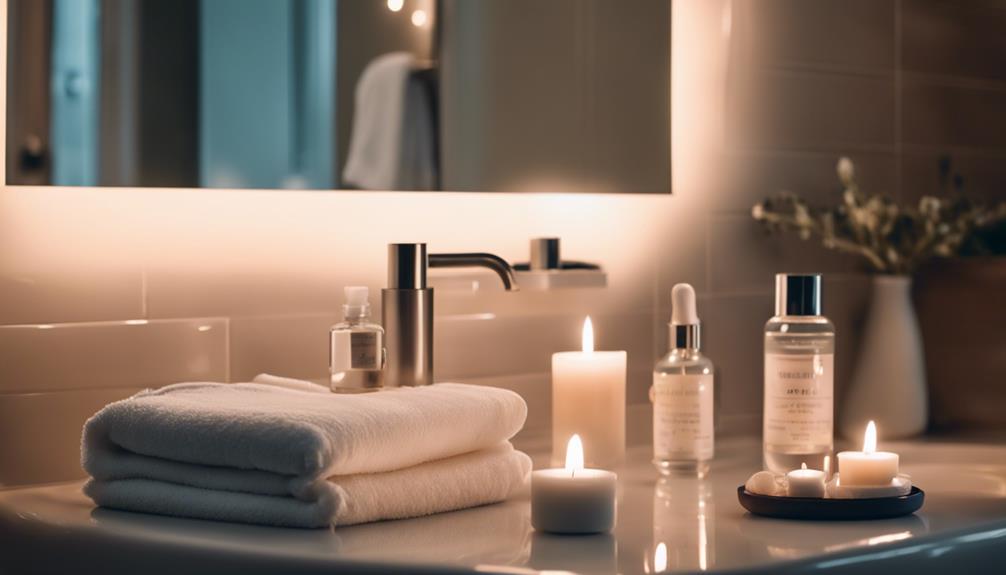
Incorporating retinol into your nighttime routine can greatly enhance your skin's texture and tone, but it's crucial to do so gradually to minimize irritation.
Here's how to effectively introduce retinol into your regimen:
- Start Slow: Begin using retinol every other night to allow your skin to adjust. Monitor for any irritation or sensitivity.
- Apply Correctly: After cleansing and toning, verify your skin is completely dry before applying a pea-sized amount of retinol. Gently tap it onto your face, avoiding the eye area and corners of the mouth to prevent excessive dryness.
- Hydrate: Follow up with a hydrating serum or a soothing moisturizer to counteract dryness and maintain skin hydration after application.
Eye Cream Application Techniques
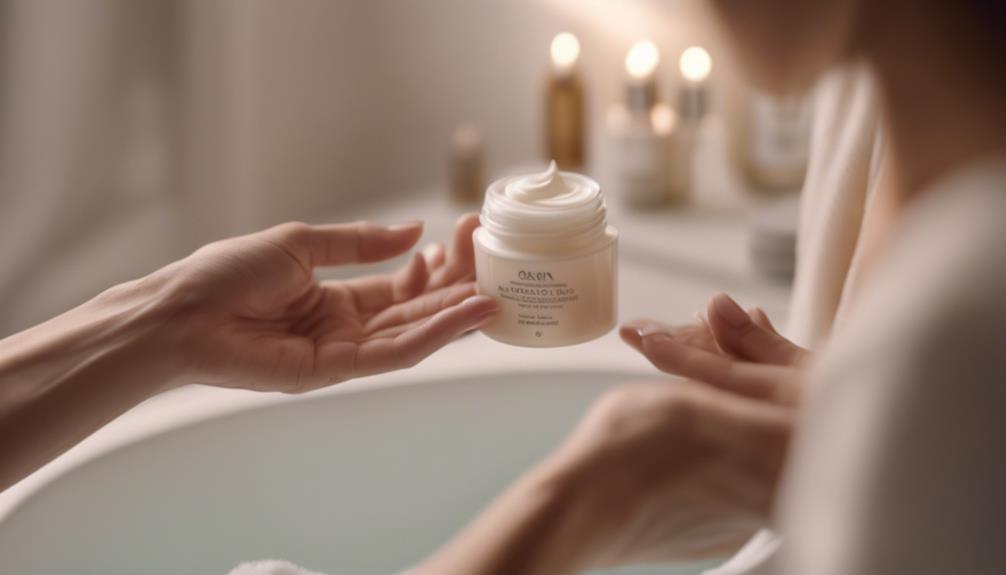
After you've introduced retinol into your routine, giving attention to your eye area with proper eye cream application techniques can further enhance your skincare results.
Start by using your ring finger, which applies the least pressure. Gently tap the eye cream around the orbital bone, avoiding any pulling on the delicate skin. Remember, a small amount—about the size of a pea—is all you need for both eyes. Applying too much can lead to product buildup and irritation.
It's best to apply your skincare in the right order, so apply your eye cream after your serums. This helps the active ingredients target concerns like dark circles and puffiness more effectively.
For ideal benefits, consider using eye cream both morning and night. Daytime formulas often include caffeine or brightening agents, while nighttime options may focus on hydration and nourishment.
Choosing the Right Night Cream
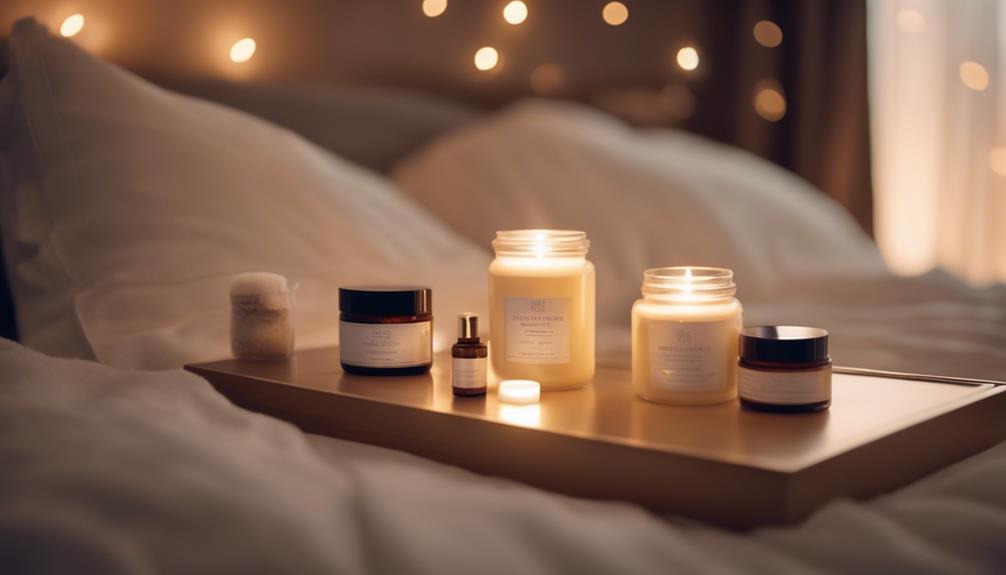
Finding the perfect night cream involves selecting a formula that hydrates, addresses your skin concerns, and complements your skin type. Here are three key factors to evaluate:
- Hydration: Look for rich hydrating agents like hyaluronic acid, glycerin, or ceramides. These ingredients restore moisture and strengthen your skin's barrier overnight.
- Anti-Aging Properties: Opt for night creams that contain retinol or peptides. These ingredients promote cell turnover and boost collagen production, helping to reduce fine lines and wrinkles.
- Specific Skin Concerns: Choose a night cream that targets your unique needs. If you have dull skin, examine formulations with fruit-derived AHAs for exfoliation and improved texture.
Additionally, assess the texture of the cream. Thicker creams work well for dry skin, while gel-based options are better suited for oily or combination skin.
You might also want to include antioxidants like Vitamin C or E to combat free radical damage while you sleep.
Finalizing With Face Oils
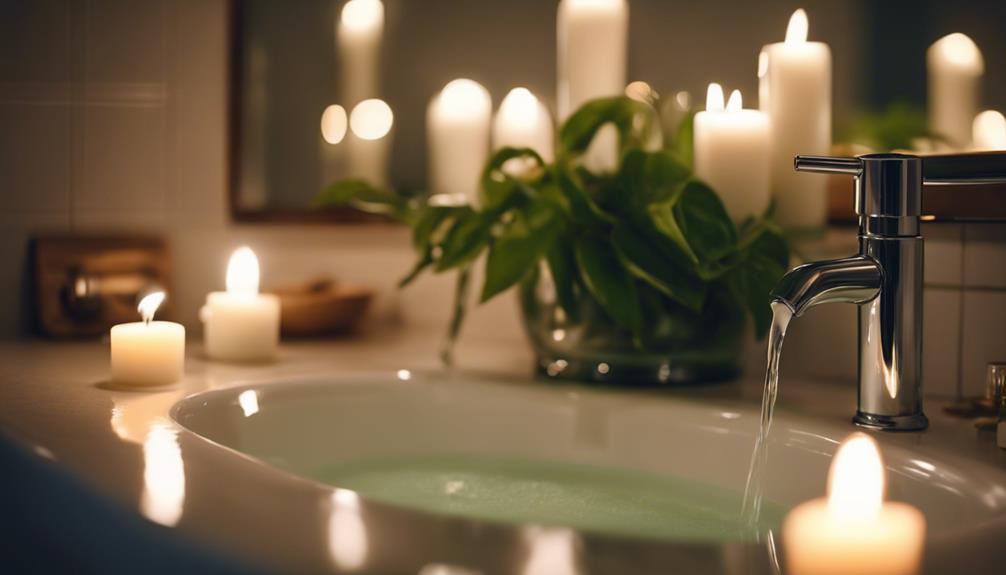
Applying face oils at the end of your PM skincare routine locks in moisture and boosts your skin's hydration levels overnight. After you've applied your moisturizers, a few drops of face oil can create a protective barrier that prevents moisture loss. This step is essential for enhancing moisture retention throughout the night.
Face oils are packed with nourishing ingredients like fatty acids from argan or avocado oil, which support your skin's natural barrier function. If you're concerned about oiliness, light oils such as jojoba can help regulate oil production, making them suitable for all skin types. When you gently massage the oil into your skin, you improve absorption and provide additional nourishment without clogging pores.
Incorporating face oils into your nighttime routine can greatly enhance your overall skin texture and radiance, giving you a more youthful appearance. By using face oils after your moisturizers, you not only hydrate the skin but also ensure that all the beneficial ingredients in your skincare products work effectively.
What are the benefits of a PM skincare routine compared to an AM PM skincare routine?
When it comes to skincare, an effective am pm skincare routine can make a big difference in your skin’s health. A PM skincare routine specifically focuses on repairing and rejuvenating the skin overnight, whereas an AM PM skincare routine ensures that your skin is protected and nourished throughout the day and night.
Conclusion
As you slip into bed, envision your skin soaking up the nourishing layers you've applied.
Each step of your nightly routine is like a gentle hug for your face, helping to rejuvenate and restore.
With every drop of serum and swipe of cream, you're crafting a radiant canvas for tomorrow.
So, embrace this self-care ritual; let it be a soothing end to your day, ensuring you wake up refreshed and glowing, ready to face whatever comes next.
